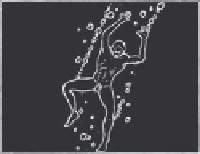Graphics Reference
In-Depth Information
Series work can be draining, with the same themes coming round again and again. There is
seldom progress from episode to episode, but you get to know the characters. Keeping i fty-two
episodes fresh is a feat, but I enjoy seeing the characters work in dif erent situations. I got to
know my characters such as Shakespeare and Achilles so l eetingly; intensely, but still l eetingly.
There is camaraderie about series work, but with the pressure there is a danger that everyone gets
disconnected from what it's all about. This disconnection can be from the story, from decisions
and from each other. The producer and director try to keep everyone involved and working to the
same end. It is hard work, but important and rewarding. Standing back after a series knowing that
you have been partly responsible for seven hours of good-quality television is not bad.
Feature fi lms
If working on feature i lms is seen as the benchmark of a career I dei nitely have not made it. My
involvement with features has been somewhat haphazard, being limited to short periods on
Mars Attacks
,
King Kong
and a week on
Neverending Story II
, but I have enjoyed being connected
with them. The sheer scale and organisational aspects seemed both daunting and exciting,
but each i lm was an adventure, not just learning a totally dif erent way of working, but also
learning new technology, and learning it in a dif erent country. I'm sad not to have done more
features, and I had hoped I might have been considered to direct one, but maybe I just haven't
come up with the goods. Of the short time I was on the features, probably, and I reassure
myself here, I may have been there too early in the long process. Most animators' involvement
in a feature may last for over a year or so, with an end result of a handful of random shots or a
complete sequence, but probably not more than a total of just a few minutes of screen time.
This is certainly quality over quantity, as features allow the luxuries of rehearsing, meticulous
planning, staging and restaging, and sometimes shooting little more of a second a day of
i lm. To have the chance to make that second absolutely beautiful, well I would snatch it.
Some animators thrive on this ultrai ne-tuning of performances, but some give their best
performance on the i rst take, with any subsequent takes losing all spark and becoming a mere
mechanical repetition. I am somewhere in between. My ideal way of working would be to
i lm a scene in one chunk, and then go back, i ne-tuning as necessary. It's hard as most of my
career has been spent shooting between nine and ten seconds a day, maybe more, with the
mental attitude that reshoots are just not even an option, and that mistakes have to be worked
through. This af ects how you approach your animation, and keeps you on your toes. This lack
of any safety net is thrilling and exhilarating and I'm not sure that I would function so well if
I had the luxury of several reshoots. I don't think I would be able to duplicate a performance
even remotely for a second take. Some things would be lost, some improved, and new bits
of business thought of. I would love the luxury of not having to rush, but I would be wary of
rehearsing too much and losing the spontaneity that is stop motion's unique pleasure.
In what acting I've done, I've found it hard to be exactly the same in each
performance, but that's the nature of live performances. Anything, from a prop
to the audience coughing can change the rhythm, and new pieces of business
appear or are dropped or timed dif erently, and the emphasis changes. This is just
the same in stop motion, where it is pretty impossible to repeat an action. This
keeps things exciting, but can make the logistics of assembling a i lm somewhat
tricky. When shooting a series the animator only thinks about performing that shot


Search WWH ::

Custom Search